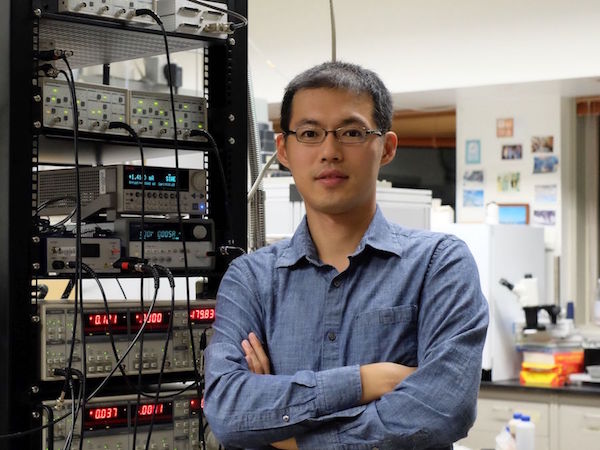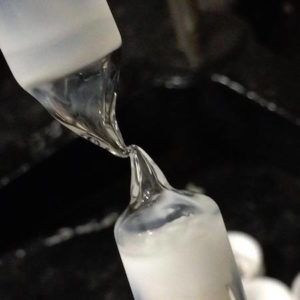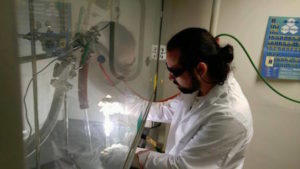
UW physics professor Jiun-Haw Chu takes a holistic approach to the development and characterization of materials with new or unusual electronic and magnetic properties
March 22, 2018
Jiun-Haw Chu, Washington Research Foundation Innovation Assistant Professor of Clean Energy & Physics, was recently awarded $1.2 million from the Gordon and Betty Moore Foundation’s Emergent Phenomena in Quantum Systems (EPiQS) initiative in support of the discovery and investigations of atomically thin and layered quantum materials. He has also been named a 2018 Alfred P. Sloan Foundation Research Fellow, having been nominated by his peers in recognition of outstanding performance and potential within the field of quantum materials. CEI talked with Chu about how these prestigious awards will advance his research, his career path, and his experience at UW thus far.
Tell us about your research. How do you design and grow these materials from the bottom up?
My group is focused on the design, growth, and characterization of novel quantum materials. Quantum materials have electronic, magnetic, and optical properties that could revolutionize energy and information-processing technologies. We can grow crystals from 85% of the elements on the periodic table through use of the flux method, in which the components are dissolved, combined, then slowly cooled. This process results in large single crystals in a relatively short time scale, ideal for exploring a wide range of material phases. Our approach differs from those that are solely focused on measurements or material synthesis, because we combine intuition from physics, chemistry and materials science. We look at the chemical formula of a material and see what atoms can be replaced to create an exciting new property.
Why did you choose the field of quantum materials?
Quantum materials is a field that allows me to touch upon some of the most profound concepts in physics, such as topology and quantum field theory. At the same time, it also requires hands-on experiments with materials that could actually impact society. I like to travel back and forth between abstract ideas and down-to-earth experiences.
What are some of the possible applications for the quantum materials that you are researching?
While our group is generally focused on fundamental studies and discovering the properties of new quantum materials, some significant research targets include high-temperature superconductors and topological insulators. Harnessing the unique magnetic and electrical properties of superconductors at accessible temperatures would be ideal for grid-scale power transmission, battery-powered airplanes, and advanced MRI machines. Topological insulators, which are materials that conduct electrons at the surface but act as insulators within the bulk, show promise in quantum computing applications.
Congratulations on the Moore Foundation grant! What advances will this allow you to make?
The Moore Foundation has supported many of the prominent figures in the field of quantum materials, so I feel privileged to be a part of that community. The proposed focus of the EPiQS research is to be able to grow a wide variety of heterostructures – crystals with regions or layers of multiple different materials. The interfaces between layers, called heterojunctions, are often the site of new material behaviors or properties.
You have also been recognized by the Sloan Foundation for your contributions early on in your career. What advice might you give a graduate student or postdoc that is looking to make an impact early on in their own clean energy research?
It’s very hard to predict what will be the next big thing in 5-10 years. To be honest, I was very lucky, and happened to be at the right place at the right time. Work on something you are passionate about, something you love, and you won’t regret it.
Tell us about your relationship with UW’s Clean Energy Institute.
CEI Director Dan Schwartz played a big part in my decision to become a professor at UW. Over lunch, Dan illustrated how CEI could be a platform for interdisciplinary, collaborative research with a focus on materials and technology that could impact society. Shortly after I arrived on campus, CEI helped me quickly establish my group and connect to other researchers. I collaborate with many other CEI professors, like my fellow physicists Xiaodong Xu, David Cobden, and Kai-Mei Fu, and am looking forward to doing even more work together through the Molecular Engineering Materials Center (MEM-C). These collaborations will also help my research under the Moore grant, as these professors have expertise in the physics of nanoscale and 2D materials.
CEI has also facilitated our efforts to build a team with the Pacific Northwest National Laboratory (PNNL) to create new heterostructures. CEI has funded two of my graduate students — Shua Sanchez and Josh Mutch — as part of the Graduate Fellowship Program, which has been a great way for them to connect to other researchers on campus and the broader cleantech community. Finally, I have collaborated with CEI chief scientist and chemistry professor David Ginger and Professor Xu to support research on the behavior of charge carriers in single-crystal perovskites, thanks to a CEI Exploration Grant.
You’re coming up on two years at UW! What have you enjoyed the most about your time here?
Everything! My wife and I were already in love with Seattle when we were graduate students, long before we moved here. I also truly enjoy the friendly and supportive environment at UW, and enjoy interacting with my colleagues, and brilliant and hard-working students.






